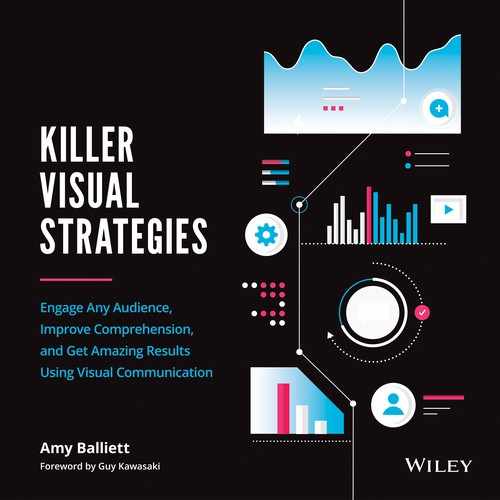PART THREE:
YOUR VISUAL STRATEGY

Figure p3.1
Source: Aberdeen Group and Vidyard, "The Impact of Video Marketing."
When I founded Killer Visual Strategies in 2010, the landscape of creative services was drastically evolving. While the large agencies of the world had become accustomed to equally large retainers and had grown complacent about the future ahead, the tide was changing.
Access to skilled services was no longer locked behind the walls of the agency elite. Talent pools were abundant and no longer restricted by geographic location, making it easy to find affordable and gifted designers. Meanwhile, thanks to the wide adoption of video conferencing, large brands had stopped expecting in-person meetings before choosing a vendor. This made it possible for small shops to compete without the expense of travel and pitch decks.
The combination of traditional pricing models, extensive overhead, and sizable staffs made it hard for seasoned agencies to course-correct fast enough. They appeared bloated and overpriced while freelancers and small agencies provided competitive rates, dedicated attention, and speedy delivery. Seasoned agencies began losing work to fledgling firms that seemed to appear overnight. Traditional firms were hurting, small teams were beginning to make headway, and organizations of all sizes were caught in the middle.
The economy was rebounding from the 2008 financial crisis, but not fast enough. At the same time, savvy marketers knew that customer demand for engaging content would only continue to grow. To keep up with that demand while the purse strings were tight, they turned to freelancers and newly launched small firms for help. For freelancers, this was the dawn of the gig economy. For small shops like mine, it was an opportunity to become something more than a lifestyle business.
But this flurry of options for organizations looking to produce visual content has also led to an abundance of subpar providers. And while consumers demand quality, content creators wrestle with shoestring budgets. As a result, inferior content has become the norm, with organizations expecting to create competitive media for just pennies on the dollar. When that media fails, they often blame the content rather than the process, budget, or level of skill that their budget allowed for.
Anyone seeking to develop a successful visual strategy must learn to choose wisely from among the plethora of content creators. While the first two parts of this book have laid a foundation for identifying and producing quality work, successful visual content can only be created with the right team executing on a solid process.
If it's your job to put a team and process in place, the pages that follow will outline the necessary steps for you to do just that. You'll discover how to leverage your options to find the right creatives for the right tasks, whether that means working with freelancers, in-house teams, or agencies. You'll learn how to surround yourself with the right team and identify true visual communicators. And you'll explore several different processes for creating great visual content.
If you are a content creator yourself, part 3 of this book will help you build a process that works for both you and your end clients. You'll learn where you fit into that process as well as where you may need to bring in partners who can contribute to a successful strategy. And you'll gain insight into the rates you can command when producing quality work.
Technological innovations and cultural shifts will continue to challenge the status quo. To deliver the best visual strategy, you'll need to prepare yourself for the future of visual content. And that is where this book concludes: with a prediction of what's to come, so you can build upon the lessons in this book and be ready for what comes next.
